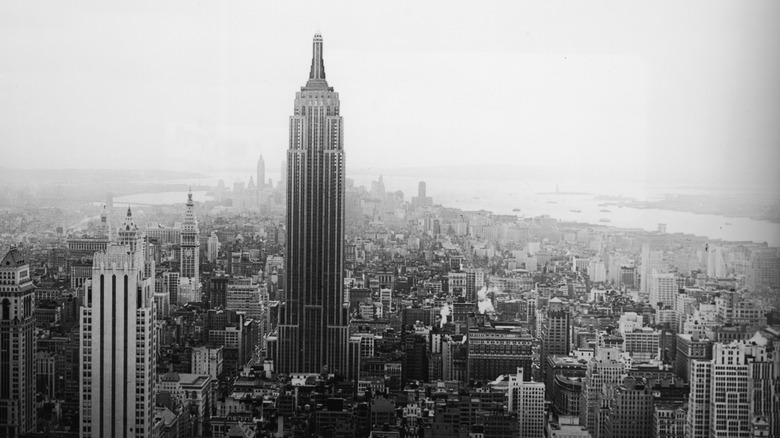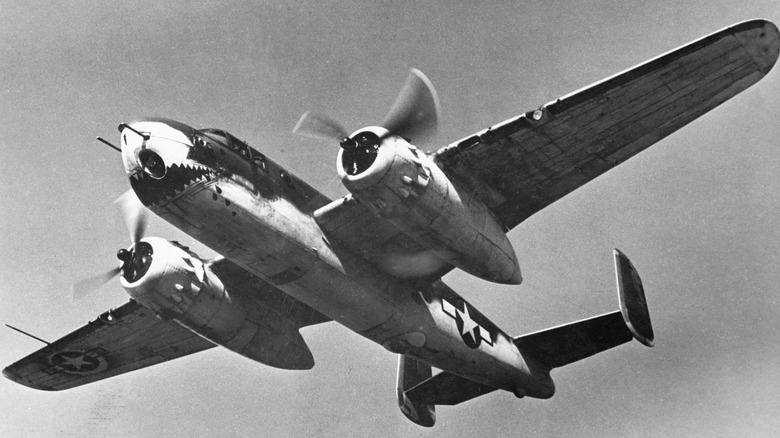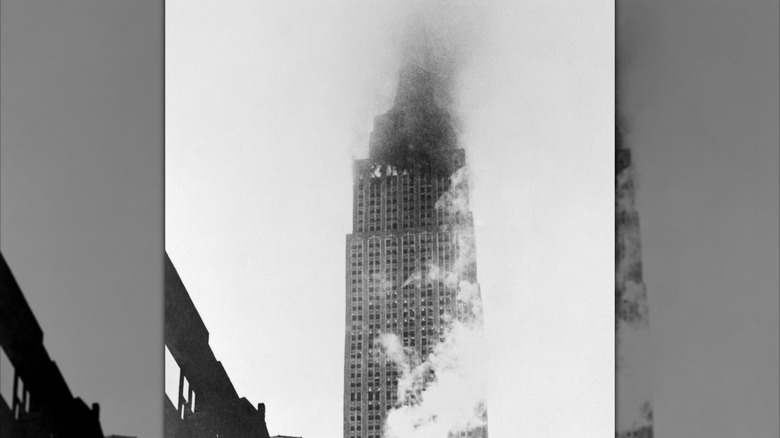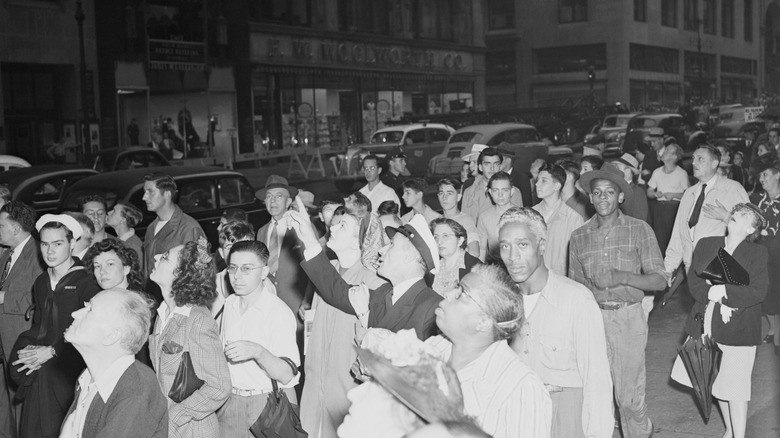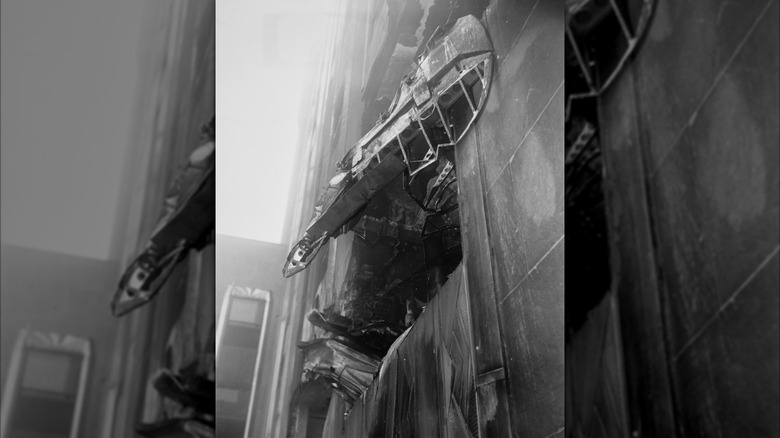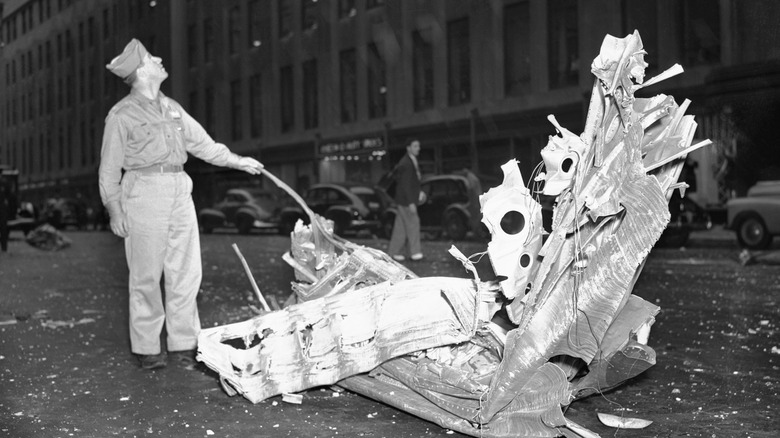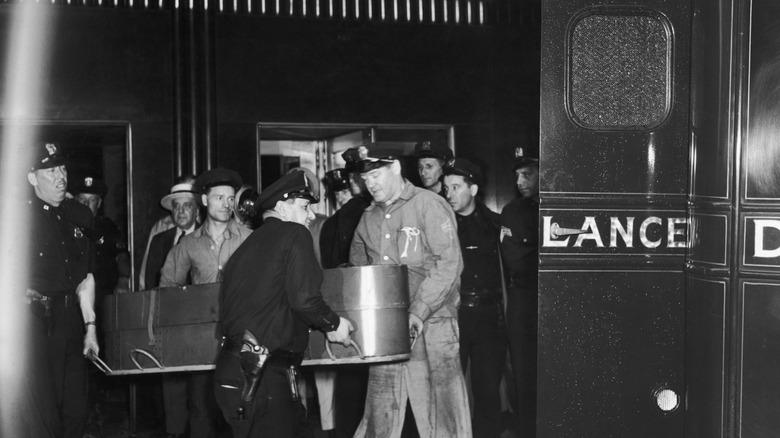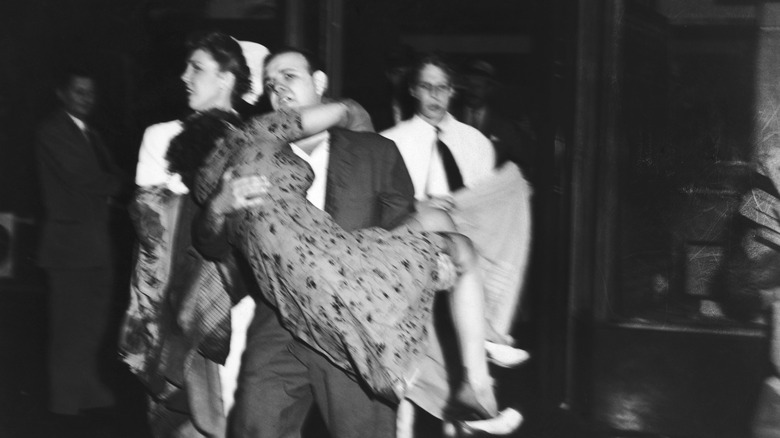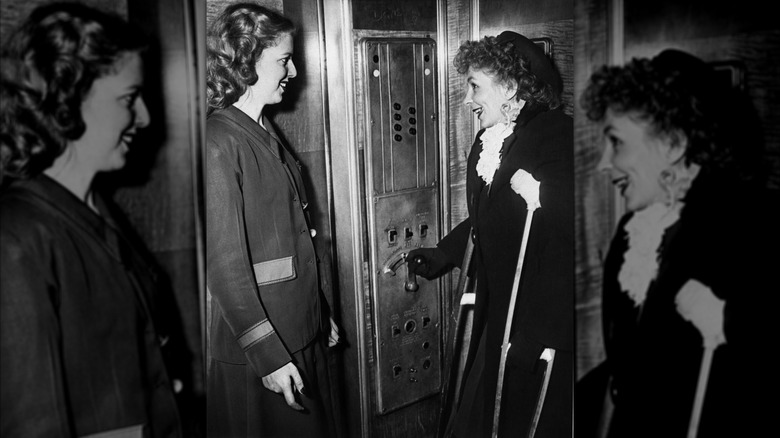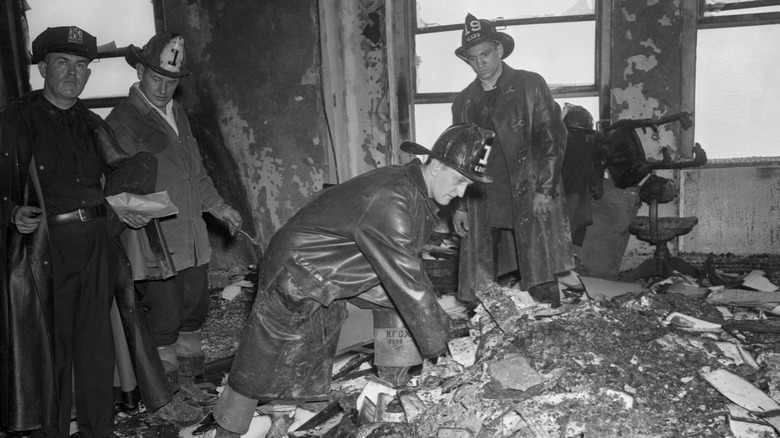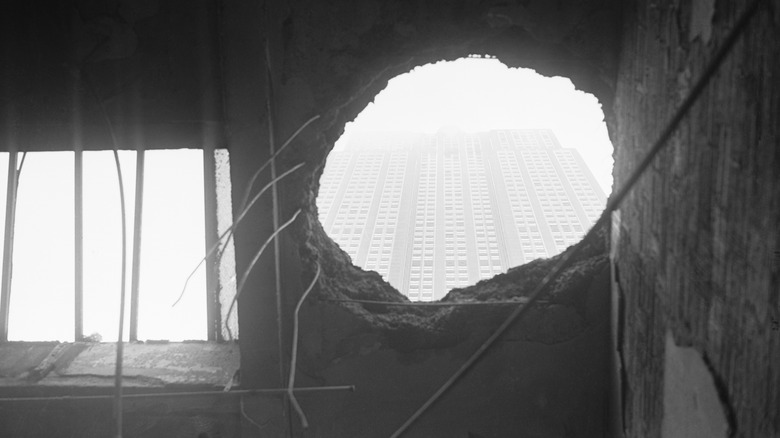The Horrific WWII Plane Crash That Shook New York City
Around the world, there are dozens of places planes don't fly over. Usually, the reason is obvious: security (the White House), active war zones (Ukraine), and Mother Nature (volcanoes). One of the locations you would least like to find yourself when in an airplane, however, is Manhattan. Home to some of the earliest skyscrapers, the island has been a forest of tall buildings for as long as planes have been in existence. This means low-flying aircraft would not only be in serious danger themselves, but risk terrifying the citizens of New York City, even decades before September 11, 2001.
On July 28, 1945, disaster struck, quite literally, when a B-25 bomber slammed into the side of the Empire State Building. Witnesses were horrified: after all, World War II was not yet over. While Germany had recently surrendered, Japan had not. Less than three months previously, five children and a pregnant woman became the only American casualties on the Allied home front during World War II, when they were killed by a Japanese balloon bomb in Oregon. Was this also an act of war? Or was it a tragic accident? This is the story of the horrific World War II plane crash that shook New York City.
The military plane was on a routine flight
The plane was a B-25 Mitchell called "Old John Feather Merchant." The captain, Lieutenant Colonel William Franklin Smith Jr., was a decorated pilot; he knew what he was doing at the controls of an aircraft and had flown 50 missions in Europe over the course of World War II. Alongside Smith was his co-pilot, Staff Sergeant Christopher Domitrovich, and a third man, Naval aircraft mechanic Albert Perna, who was traveling to be with his parents following the confirmation that Perna's brother had been killed in an attack on a U.S. Navy ship near Japan. They were flying a routine mission, but what should have been an uneventful troop transport between two bases went horribly wrong.
That day, thick fog limited visibility. Smith's wife, Martha, told the AP (via The Winston-Salem Journal), "He was so dubious about the weather and said flying conditions would be poor." Leaving from Bedford Army Air Field in Massachusetts, Smith headed for LaGuardia in Queens. However, when he contacted the tower there, he was told that visibility was so bad he should reroute and land at Newark, New Jersey, instead, per the NYC Department of Records. Ignoring this recommendation, Smith continued towards his original destination, but became disoriented due to the fog and ended up flying through Midtown Manhattan.
Lieutenant Allen Aiman, a pilot who'd flown planes in the Pacific earlier in the war and who witnessed the crash, told The New York Times, "The visibility was zero. I was flabbergasted. I couldn't believe my own eyes when I saw the plane come out of the overcast." Flying extremely low to get out of the fog, Smith would have seen where he was and realized the plane was in trouble.
The plane almost hit several other buildings
While we don't know his reaction upon seeing where he and the plane were, Lt. Colonel William Smith must have immediately realized the trouble he was in as he had to maneuver to avoid several skyscrapers, including the Chrysler Building and the New York Central Building.
Nanette Morrison, a typist who worked on the 38th floor of an office near the Empire State Building, told UP (via The Cleveland Press) the plane flew so close to her window that she could see the two crew members in the cockpit: "I almost waved to them. Then I realized they were in trouble." Boston Braves pitcher Mort Cooper was in his room at the Commodore Hotel when he saw the plane pass by before coming dangerously close to the RCA Building (now known as 30 Rockefeller Plaza). Unfortunately, while these maneuvers successfully avoided all of those buildings, they resulted in the plane heading straight towards the Empire State Building.
In an office just five blocks away, James E. Ager was using a Dictaphone when the plane flew by, and it actually picked up the sound of the crash. Arthur Weingarten, author of a book on the tragedy called "The Sky is Falling, told NPR, "... you can hear [Ager] on the tape dictating the letter and the sound of the engines gets louder and louder and louder as it passes by his office window. Suddenly his voice stops, and a second or so later on the tape you hear a dull thud, which is the impact of the bomber into the Empire State Building."
Dozens of witnesses were helpless to stop the disaster
One man who saw the crash, Army Air Force officer Lt. Aubrey B. Condit, estimated that those on the plane had a full minute between when they realized a crash was inevitable and the impact. As he told The Brooklyn Eagle, "The pilot ... had a minute to see how he was going to die."
Interviews with witnesses on the ground and in nearby buildings reveal that it was clear to everyone else, as well, that a disaster was imminent. Sports announcer Stanley Lomax saw the plane from his car. In a piece he wrote for UP (via The Cleveland Press), he recalled yelling impotently to the pilot, "Climb, you damn fool, climb!" A New York Times editor named Walter Daniels was walking along the street when the plane flew overhead. "The roar of the motors sounded ominously low, and it seemed to be going at a terrific speed. I believe people must have sensed disaster," he recalled (via Warfare History Network). "Everyone in sight started running for Fifth Avenue to see what was happening."
Nanette Morrison, the typist who had almost waved to the pilots from her office, told UP of the terrible seconds after the aircraft passed her building: "The pilot was obviously trying to climb, but the plane didn't go up except slowly, so slowly it almost drove you mad watching his completely futile efforts" (via The Cleveland Press). There was nothing anyone, including the pilot, could do.
The plane crashed into the 79th floor
Unable to climb fast enough to get over the then-tallest building in the world, the plane hit the Empire State Building around the 79th floor. At that moment of impact, Gloria Pall was working in the USO office on the 56th floor. She told NPR, "I was at the file cabinet and all of a sudden the building felt like it was going to just topple right over. It just threw me across the room, and I landed against the wall. People were screaming and looking at each other and didn't know what to do. We didn't know if it was a bomb or what happened."
Louis Petley was on the building's 86th-floor observation tower, pointing out the city's famous sites to 35 tourists when the plane hit. "I never heard anything like it in my life," he told The Brooklyn Eagle. "I jumped three feet in the air. The people started rushing around. I told them, 'wait a minute, now wait a minute!'" Despite being above the impact zone, Petley managed to get everyone in his group out of the building safely.
The 78th through 80th floors had an 18x20 foot hole from the impact; 20 floors had their windows blown out. Wreckage flew everywhere (some people even claim to have pieces of it today). The resulting damage, complete with part of the plane sticking out of the building, looked so incredible that fact-checkers, including Snopes, have had to confirm to modern audiences that the images are real and not photoshopped or AI-generated.
Several nearby buildings were also damaged
While the plane only impacted the Empire State Building, narrowly missing several other buildings it flew past, the disaster still caused damage to nearby structures. The plane did not disintegrate due to the impact, and the momentum of the crash sent parts flying. Bits of the plane that were found on other buildings or in the street included one of the engines, part of the fuselage, a wheel, and the landing gear.
Frank Rinaldi was working in a nearby barbershop when he heard the impact. Seconds later, a metal slab slammed into the front window of the shop, sending customers diving for cover. Mortar and glass from the Empire State Building fell into the streets, landing inches from where a window cleaner had been working just minutes before. The engine was thrown all the way down the block and crashed into a penthouse art studio, where it burst into flames.
Other bits of the plane struck buildings, landed on rooftops, and ended up in the streets next to astonished witnesses. Somehow, despite this rain of heavy, sometimes flaming debris, no one outside the aircraft or the Empire State Building was killed.
There were dozens of injuries and fatalities
In what must have eerily foreshadowed what it was like inside the World Trade Center when 9/11 happened, those in the Empire State Building closest to the impact site witnessed horrible scenes. Decades later, Therese Fortier Willig still vividly remembered seeing her colleague suffer what would prove to be life-ending injuries. "Mr. Fountain was walking through the office when the plane hit the building, and he was on fire. His clothes were on fire. His head was on fire," Willig told NPR. "Six of us managed to get into this one office that seemed to be untouched by the fire and closed the door before it engulfed us. There was no doubt that the other people must have been killed."
Donald Moloney, a 17-year-old Coast Guard hospital trainee, recounted what he saw that day in particularly gruesome, if matter-of-fact, language to The Brooklyn Eagle: "I picked up two heads and parts of four bodies and helped stack them on a table. ... I guess I must have carried and treated about 20 people. All of them were burned, and suffering terribly from shock."
Between the three occupants of the plane and those in the building, 14 people died and 24 were injured. However, it could have been far worse. Since the crash occurred on a Saturday, only about 1,500 people were in the building. This meant there were far fewer casualties than would have been the case on a weekday, when the skyscraper was normally stuffed with up to 15,000 people.
Many unlikely heroes emerged
Before, and even after paramedics arrived at the scene of the accident, regular people did what they could for the injured. Donald Moloney, the 17-year-old who didn't blink at stacking body parts on tables, ran to a nearby drugstore when he saw the accident. He demanded the largest first aid kit they had, and when he got to the Empire State Building, he started easing the pain of the injured with injections of morphine — despite worrying he could be prosecuted for drug offences for doing so.
Engineer Arthur E. Palmer and his assistant, D.J. Norden, managed to stop a badly burned woman from jumping out a window, then used a hammer to break their way through the wall of their office. "When [the hole] was big enough, Norden went through," Palmer remembered (via Warfare History Network). "He took the elevator girl's arms. I took her legs and we hauled and shoved her through. After I crawled out, we took her by the arms and led her through the empty office into a corridor that led us to a stairway." She later thanked them for saving her life.
Penny Skepko and Barbara Brown, clerks in the Air Cargo office, chose not to evacuate in order to help care for the injured. This probably saved their lives — the elevator they would have taken plunged to the bottom of the building. Despite their second brush with death that day, the two women assisted doctors and nurses in the building for five hours.
A woman survived the longest elevator drop in history
The tragedy that day resulted in one of the most astonishing tales of survival ever. Betty Lou Oliver (pictured right) was an elevator attendant who was on the 80th floor, right next to the impact site. The crash badly burned her, and when paramedics arrived, they put her in one of the skyscraper's elevators to take her to get medical treatment. She was the only one who had stepped into the car when the cables, damaged by the crash, snapped.
From her hospital bed, Oliver told her family what happened next, and they recounted it to the media, including The Courier-News. "The elevator seemed to stop and shudder for a moment. Then it began plummeting downward. I tried desperately to stop it. ... Nothing happened. I started yelling and pounding on the floor," Oliver said. "... I was going down so fast that I just had to hang onto the sides of the elevator to keep from floating." Oliver fell 75 stories. The impact broke her pelvis, back, and neck. Astonishingly, she lived, setting the record for the longest fall survived in an elevator, per The Guinness Book of World Records.
Despite the fact that you are unlikely to die in an elevator accident, the very slight possibility means that many people hate riding in elevators. While stories of the world's deadliest elevators won't help ease that fear, Betty Lou Oliver's experience should give even the most elevator-phobic person a sense of hope.
The rescue was a huge success for firefighters
Of the many heroes that emerged from the tragedy, the New York Fire Department particularly stood out. The plane crash sent flaming gasoline pouring through the building, which started three separate fires in different areas of the upper floors of the building. It was an unprecedented conflagration — the highest fire ever in New York City history at that time.
Hundreds of firefighters were dispatched to the four-alarm disaster. Their appearance on the scene of the accident was a huge relief to those in the Empire State Building. Therese Willig told NPR, "All of a sudden, here were firemen, and they're coming to rescue us, you know, all dressed up in their rain coats and whatever they wear. You know, and it was just wonderful. We climbed out through the broken glass. I was just grateful to be alive."
The fire brigade did an exceptional job of containing the fire, and the resulting damage was very limited. One of the more cutting-edge techniques was the use of walkie-talkies. They had been in limited use by the fire department for less than a decade, but with phone lines in the building severed by the plane crash, they proved vital for firefighters dozens of stories up to communicate the situation to those on the ground. The success of their mission led other fire departments and even other countries to adopt some of the NYFD's techniques.
One year later, another plane almost hit the building
It is incredible that an accident like the one that occurred on July 28, 1945, was even possible. There were several restrictions on flying around New York City, including a rule that planes could not descend below 5,000 feet. Even including the length of its antenna, the Empire State Building is only 1,454 feet tall, meaning there should have been a very big buffer zone. After the disaster, Mayor Fiorello La Guardia was furious. Reporters for The New York Times overheard him angrily insisting, "I told them not to fly over the city." Before the day was out, two different probes, one by the U.S. Army and the other by the New York Fire Department, were already underway.
So you would think that there was zero chance of a similar accident ever happening again. Well, amazingly, a mere four days before the first anniversary of the tragedy, another plane came dangerously close to crashing into the Empire State Building, terrifying onlookers.
Witnesses reported that a twin-engine plane flew within 200 feet of the skyscraper, even lower than the military aircraft had been, swerving out of the path of the building when it was at the level of the 68th floor. While office workers told police what they saw, the aircraft had no obvious markings, and it was never determined who was flying it. To this day, it is a mystery, so we may never know how such a tragedy came so close to happening a second time in a single year.
